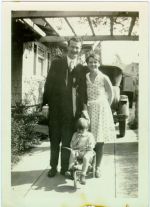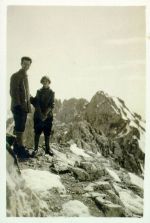
Early Years: Education, Teaching and the Chemical Bond
Page 4-2
| 1925 | Crystallography and quantum theory: "The entropy of supercooled liquids at the absolute
zero" Manuscript, and copy of 1950 handwritten note about the genesis of this paper. Manuscripts and Typescripts of Articles 1925a.2 (Catalogue Vol. I page 153) |
| 1925 | Crystallography: "The structure of crystals" Annotated typescript with handwritten drawings, formulas, and pages of notes. Manuscripts and Typescripts of Articles 1925a.4 (Catalogue Vol. I page 153) |
| 1926 | Guggenheim Fellowship / Europe Correspondence with Arnold Sommerfeld, director of the Institute of Theoretical Physics in Munich, and related materials. Handwritten letter of introduction to the Royal Society for Linus Pauling, in German. Sommerfeld offered Pauling’s paper on many-electron atoms to the Royal Society for publication. Correspondence 366.1-366.4 (Catalogue Vol. I page 91) See also: Material on trip to Germany, Science 2.001 (Catalogue Vol. II page 3) |
| 1927 | Guggenheim Fellowship / Europe: "The sizes of ions and the structure of ionic crystals" Pauling’s first major theoretical paper. Publications 1927p.4 (Catalogue Vol. I page 107) |
| 1927 | Guggenheim Fellowship / Europe: "The theoretical prediction of the physical properties
of many-electron atoms and ions..." One of Pauling’s most-cited papers, in which he brought to the explanation of crystal structures the new quantum mechanics that he was studying in Europe. View Online: Publications 1927p.5(Catalogue Vol. I page 107) |
| 1928 | Chemical bond: "The shared-electron chemical bond" A note to the Proceedings of the National Academy of Sciences on how quantum mechanics could explain the tetrahedral carbon atom; prefigures Pauling’s chemical bond papers and resonance theory of 1931. View Online: Publications 1928p.1(Catalogue Vol. I page 107)  Linus, Ava Helen, and Linus Pauling Jr. in their driveway, Pasadena, California, 1928. LP Photographs, 1928i.2 |
| 1929 | Crystallography: "The principles determining the structure of complex ionic crystals" A much-cited paper. Publications 1929p.1 (Catalogue Vol. I page 108) |
Return to Ava Helen and Linus Pauling Papers Home
Table of Contents
- Introduction
- Ways to Approach the Curriculum
- Using Archival Materials in Special Collections
- Early Years: Education, Teaching and the Chemical Bond
- Part I: 1901-1924
- Part II: 1925-1929
- Part III: 1930-1939
- Middle Years: War Work, Peace Work and Protein Structure
- Later Years: Molecular Disease and Orthomolecular Medicine
- Topical Readings
- Websites Regarding Linus Pauling
- Appendix: General Guidelines for Use of Special Collections Materials
- Acknowledgements


